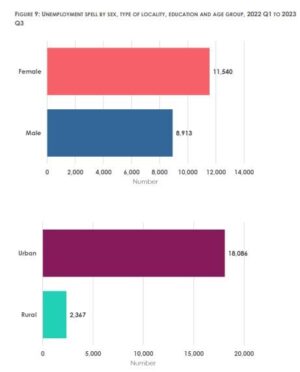By Juliet ETEFE
About 22.3 percent of persons who experienced an unemployment spell from the first quarter of 2022 to the third quarter of 2023 had tertiary education, the Ghana Statistical Service’s Annual Household Income and Expenditure Survey: Quarter 3 2023 Labour Statistics Bulletin, has revealed.
An unemployment spell refers to an uninterrupted period within which a person has stayed unemployed. Also, almost half – 48.8 percent – of persons who experienced an unemployment spell over the 21-month period had completed secondary education.
The findings also established that across all seven quarters – 2022 Q1 to 2023 Q3, about 20,000 persons experienced an unemployment spell. This was highest among females – 11,540; persons in urban areas – 18,086; persons with secondary education – 9,987 and persons aged 15 to 24 years – 9,341.

Also, almost 200,000 persons experienced an unemployment spell of at least 12 months between 2022 Q1 and 2023 Q3, says the study.
Presenting the highlights of the findings in Accra, Government Statistician, Professor Samuel Kobina Annim, noted that between the first quarter of 2022 and the third quarter of 2023, the absorption rate in terms of employment-to-population ratio increased, while youth not in employment, education, or training (NEET) reduced, with unemployment recording an upward trend.
On a year-on-year basis, there was an increase in the unemployment rate over the period, with the highest rate recorded in the Western Region at 7.8 percent; Greater Accra, 5.0 percent; and the North East Region at 3.7 percent. The regions that recorded the highest year-on-year decline in unemployment rates were Northern, negative 6.3 percent, Savannah, negative 2.9 percent and Bono East, negative 2.9 percent.
Commenting on the findings, Prof. Annim underscored the need to address unemployment issues differently across the administrative regions, especially in Greater Accra and Ashanti, the only two regions to consistently record unemployment rates higher than the national average during the seven quarters.
Greater Accra was the only region that consistently recorded a youth not in employment, education, or training (NEET) rate higher than the national average in all quarters.
The findings also indicated that “on average, more than three-quarters – 77.4 percent – of the total unemployed persons comprised youth aged 15 to 35 years – 1,374,329 – in the first three quarters of 2023. Youth not in employment, education, or training (NEET), however, increased by 3.6 percentage points between quarters two and three in 2023, reversing a downward trend in the previous four quarters.
Mobility across labour force
The findings show that about 440,000 persons joined the labour force between 2023 Q1 and 2023 Q3, of which more than 60 percent were employed during the period.
Statistics on labour mobility from 2022 Q4 to 2023 Q3, indicate that among the 530,000 persons who transitioned from employment to unemployment between 2022 Q4 and 2023 Q1, more than half -280,000 – remained unemployed in 2023 Q2.

Vulnerable employment
According to the study, vulnerable employment – people employed in low-skilled, low-paid jobs with little job security – was consistently higher for females at 77.8 percent than males at 57.6 percent – about 20 percentage points – across all seven quarters.
North East, Savannah and Oti Regions consistently recorded the highest percent of employed persons in vulnerable employment in the first three quarters of 2023.
Analysing these findings, Prof. Annim said it calls for an assessment of the preparedness of persons entering the labour force and labour transitions across different economic activity ranks.
He added that labour transition, especially exits-out-of-employment status and their re-exits, should invoke conversations on job creation.
He also emphasised that the use of administrative data to tackle unemployment spells and labour transitions is imperative.
AHIES
The Annual Household Income and Expenditure Survey (AHIES) is the first nationally representative high-frequency household panel survey. The 2023 Third Quarter Labour Statistics Bulletin provides quarterly statistics on key labour statistics for seven quarters from the first quarter of 2022 to the third quarter of 2023.
This bulletin presents quarterly labour force statistics for the population 15 years and older. It provides information on mobility across labour force statuses, unemployment spells, yearly and quarterly changes in employment and unemployment rates and other labour statistics. These statistics are disaggregated by sex, type of locality, region, and selected socio-demographic characteristics.










